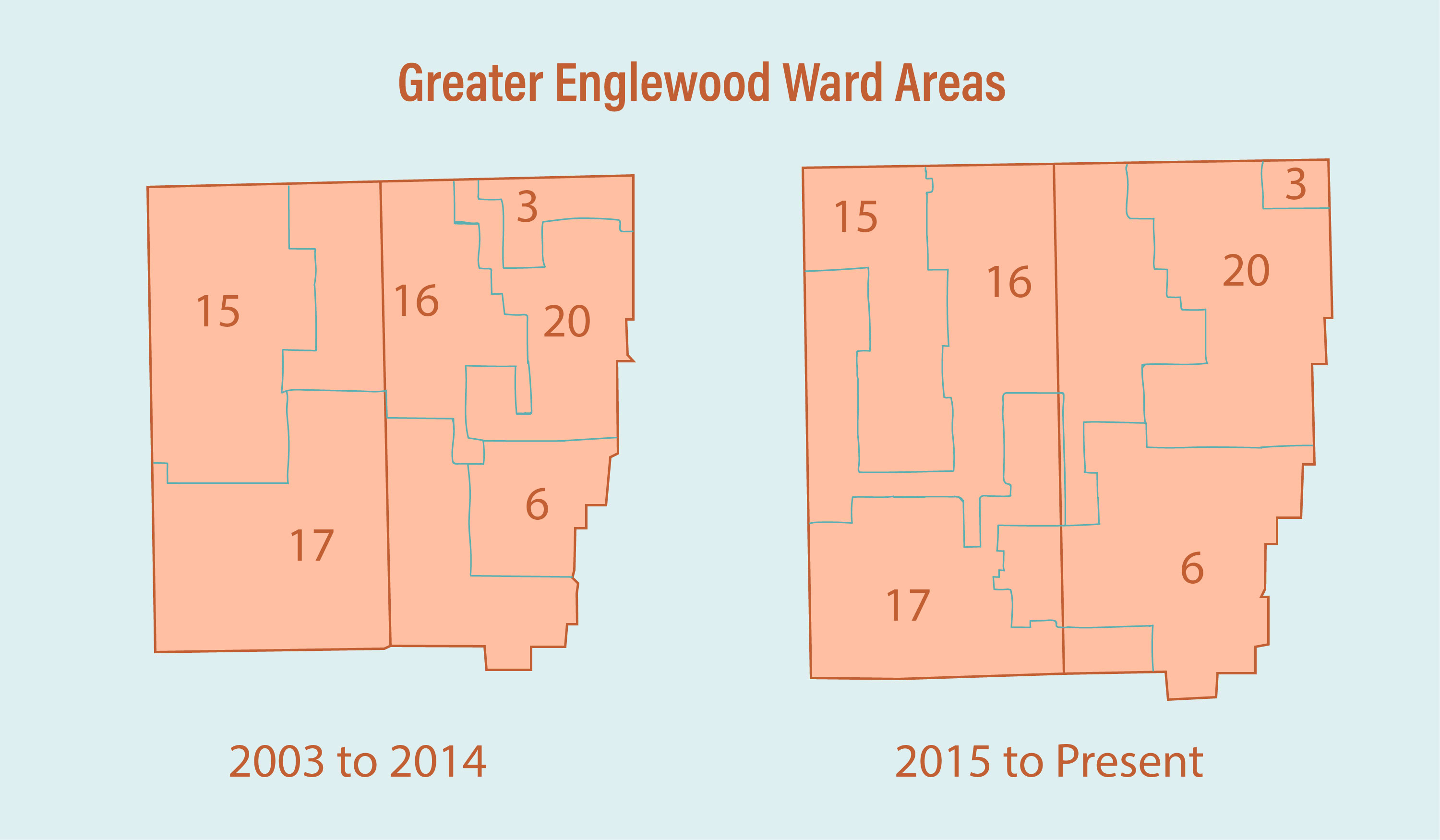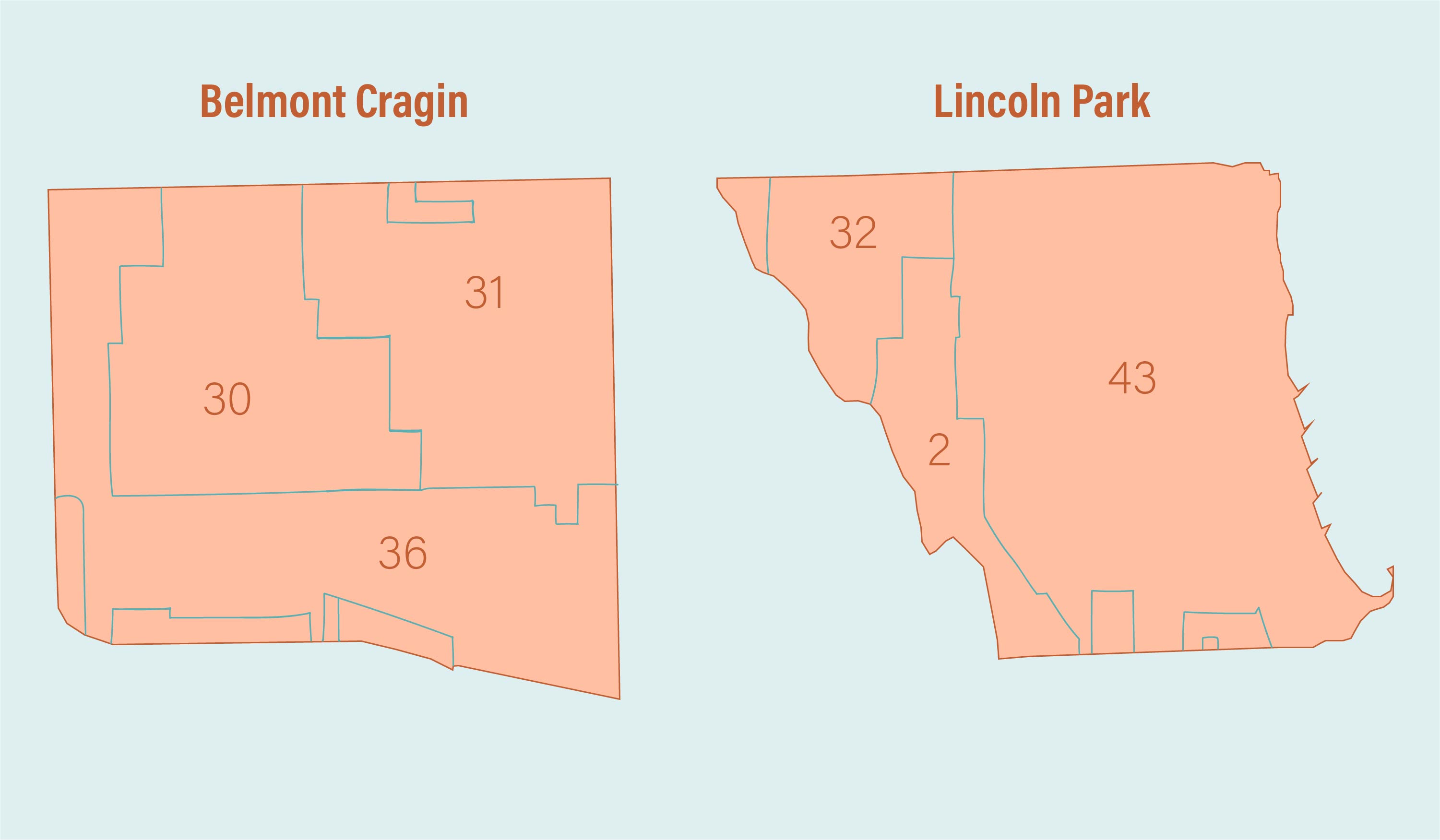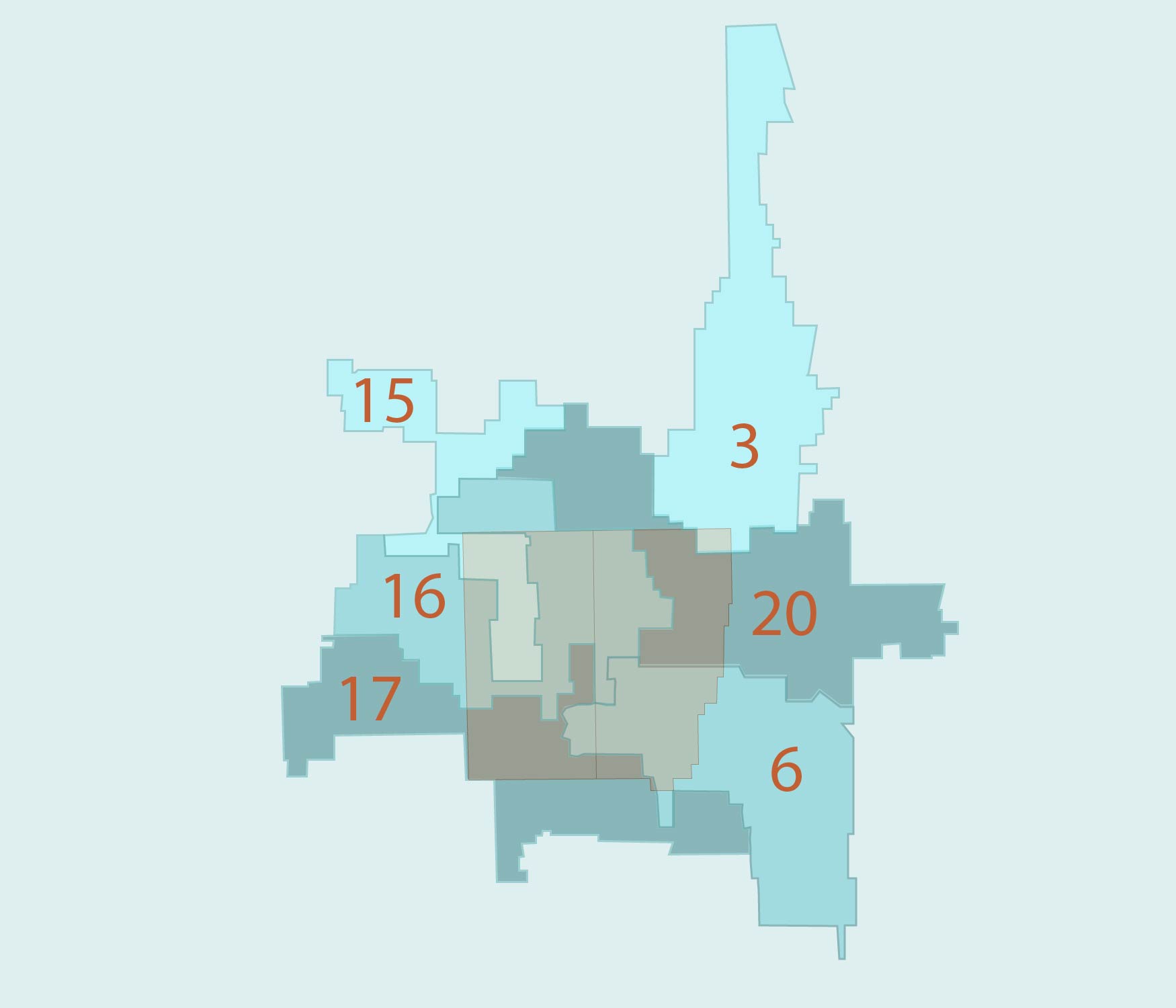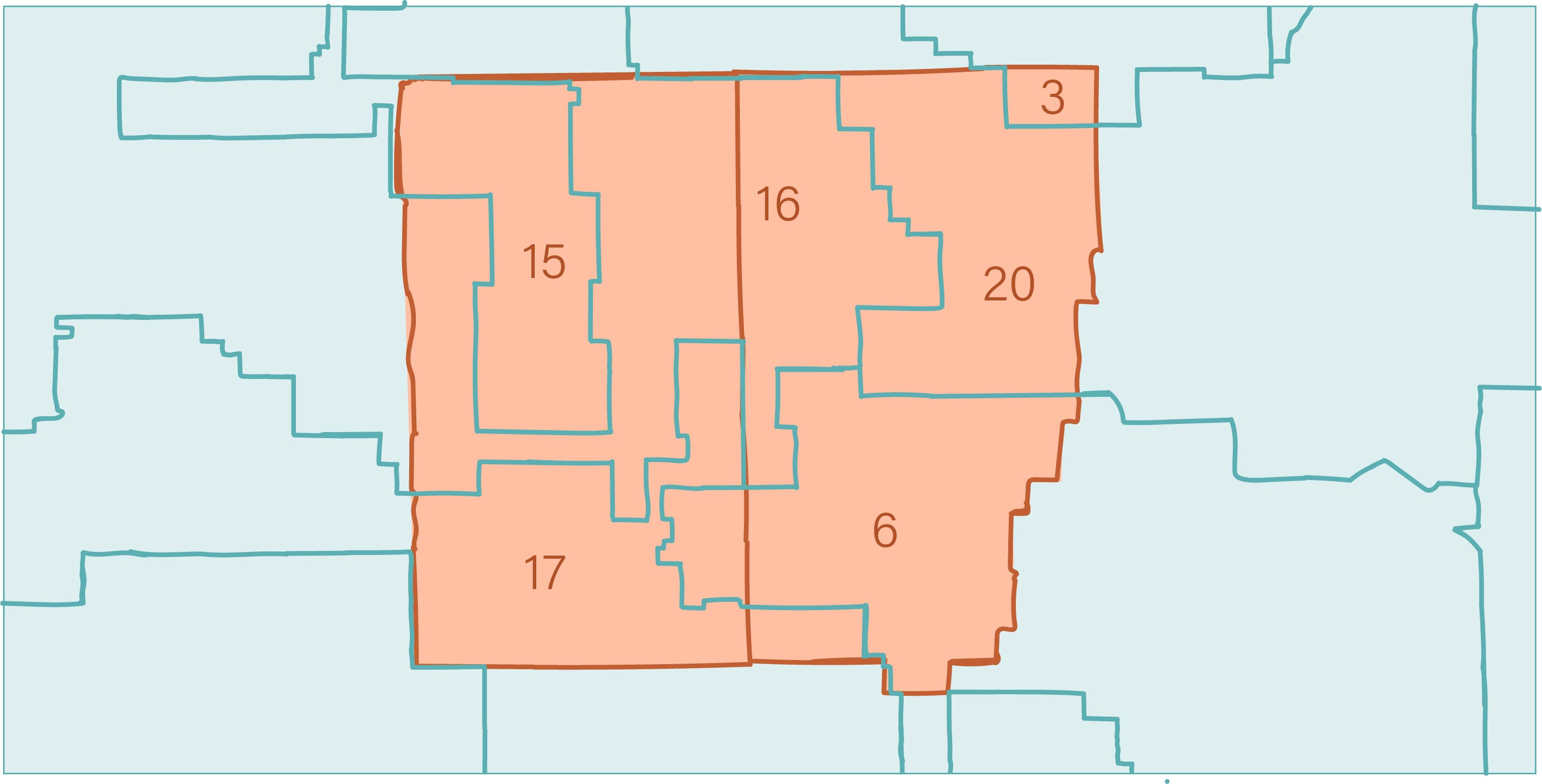During the 2015 municipal election, Englewood native Rodney Johnson remembers the confusion he and other Englewood residents experienced when they tried to vote at their normal polling place only to find out it had changed the year before, following Chicago’s ward remap.
“I was used to voting in one place, and when I went to that one place I assumed it would be there,” Johnson said.
For decades wards have chiseled their way into the Greater Englewood area — composed of both Englewood and West Englewood on Chicago’s Southwest Side. The community has been a part of five wards since the ‘70s. After the 2010 Census, the boundaries of the wards within the Greater Englewood area changed significantly. This is because each of Chicago’s 50 wards is supposed to have roughly the same population. As Chicago’s population changes, so do ward boundaries.
The 6th Ward boundaries now take up a larger portion of its southeast corner of Englewood. Meanwhile, the 17th Ward takes up substantially less of the southern part of the community. And the 16th Ward’s boundaries appear to have flipped upside down, now zigzagging through the western end of the community.
In 2015, when the ward boundaries officially changed, so did the precinct polling places.
When it came time to vote for the 2015 election, Johnson said he and other residents went to the precincts they were used to voting in, not realizing that with the changed ward boundaries, their polling place had also moved. Johnson remembered receiving a new voter’s card in the mail. However, he assumed his polling place had not changed.
Today, the 6th, 15th, 16th, 17th and 20th Wards, along with a small portion of the 3rd Ward, divide through the community area. Johnson lives in the 17th Ward, though the 6th Ward is right across the street from his house.

(Marissa Nelson, 14 East)
Across the city, Chicago’s ward map appears peculiar. The city’s more than 230-square-mile landscape is divided into 50 oddly shaped wards with boundaries that zigzag across the map. The 1st Ward, for instance, resembles a lopsided letter “u” that engulfs the southern boundaries of the 32nd Ward.
Compared to a map of Chicago’s 77 community areas, the ward map appears disorganized. The neatly shaped community areas hardly align with Chicago’s wonky ward boundaries. In fact, most community areas are a part of multiple wards.
Belmont Cragin, a community on Chicago’s Northwest Side, is a part of three wards: the 30th, 31st and 36th Wards. Each ward occupies roughly the same amount of the community, with a small portion of the 29th Ward overlapping on the southern border. Meanwhile, Lincoln Park on the North Side is also a part of three wards: the 2nd, 32nd and 43rd. However, unlike in Belmont Cragin, the 43rd Ward occupies the majority of Lincoln Park and is considered nearly synonymous with the community to many in the area.
Each ward is governed by an alderman who has a great deal of power in terms of what happens in the area, from new developments and zoning to infrastructure and the budget. Aldermen serve four years at a time and they aren’t confined to term limits as long as their constituents continue to elect them. Together, Chicago’s 50 aldermen make up City Council and make citywide decisions as well.

(Marissa Nelson, 14 East)
“If you are in a ward where the familiar neighborhood identity and the ward boundaries are reasonably close together, you probably have more of a sense that you can work through your alderman in terms of dealing with the city government on various issues,” said Larry Bennett, a former political science professor at DePaul University who has written numerous books about Chicago politics.
However, many communities in Chicago are not easily aligned or associated with specific wards, and Englewood is a prime example. This can make a resident’s understanding of who represents them more complicated and hinder a community’s ability to advocate for themselves and make change in their neighborhood.
This challenge is then exacerbated by the adjustment of ward boundaries around the city every 10 years or so. It appears that knowing exactly who to go to with neighborhood concerns becomes murky without the guarantee of consistent representation. Meanwhile, the process of addressing community issues that permeate ward boundaries is sometimes inhibited by the presence of multiple aldermen within individual communities.
The only ward that is mainly located in Greater Englewood is the 16th. However, none of the wards within the Greater Englewood area is truly considered synonymous with the community, as the 43rd Ward is with Lincoln Park. Each ward expands into other communities in which the majority of their constituency resides. Much of the 20th Ward exists in Woodlawn and most of Chatham belongs in the 6th Ward.
“You have four other minority portions of the other four wards that actually are a part of Greater Englewood,” Johnson said. “So, the challenge that comes from there is that people outside of the community proper actually decide what the actual [voter] turnout is.”
Some residents feel that an alderman’s attention is drawn to the other communities in which the majority of their voting base resides.
“As a 17th Ward member, we know Auburn Gresham is the main power source and they dabble in Englewood,” said Phil Sipka, the founder of Kusanya Cafe in Englewood’s 6th Ward.
Although Sipka lives just three blocks from the cafe, he works and lives in two separate wards.
“There is a lot of disinterest in spending time appealing to an Englewood electorate when that’s less than half of where your base is from,” Sipka said.
Ald. Roderick Sawyer’s (6th) ward also includes parts of Park Manor, Chatham and Auburn Gresham. Sawyer said he makes an effort to spend time in every community each week, but acknowledged that it can be difficult to balance the communities.
“There is a bit of a challenge in trying to represent several different community areas that were not once represented to any great degree,” Sawyer said.
Recently, the five aldermen in Englewood — including Sawyer — started making a more concerted effort to work together and serve Englewood residents. Last week, Resident Association of Greater Englewood (RAGE) organized a town hall at Kennedy-King College with the five major aldermen in the Greater Englewood area. Alds. Stephanie Coleman (16th), David Moore (17th), Jeanette Taylor (20th), Sawyer (6th) and Raymond Lopez (15th) listened to residents’ concerns.
“I think we’ve got a group that is concerned about the whole of Englewood and I think my colleagues are very decided in terms of what we can do collectively to improve life for our Englewood residents,” Sawyer said.
While organizers said it was the first event of this nature in their memory, the Chicago Crusader reported it had been at least 10 years since the wards’ aldermen came together like this — before any of the current aldermen were in office. Residents from every ward filled the room and lined up to speak for their allotted two minutes (which ended up taking the event long past its end time). No matter their ward, residents echoed concerns of homelessness, gentrification, family support services and equity in cannabis legalization and dispensary licenses.
Lopez thought the town hall was productive. “There were a lot of projects that were brought up that expand beyond ward boundaries,” Lopez said. “If we’re able to coalesce around three or four core principles that we can all agree on, then we can kind of use that as a focal point when we go back to our respective wards to try and come up with coordinated strategies for addressing certain areas.”
The five aldermen are hoping to host the town halls more consistently, possibly on a quarterly basis, Sawyer said.

(Marissa Nelson, 14 East)
What the irregular map means for residents
Today, the ward map of Greater Englewood looks like a jigsaw puzzle. Ashland Avenue, a main artery in the area, touches three of its wards — including the 16th Ward, which crosses the avenue twice.
At the resident level, the irregular boundaries make it difficult to understand who to go to about various problems in a community area. On a larger scale, the high concentration of wards dilute power, making it more difficult for a community to address issues in the area that permeate through the boundaries of a single ward.
Jim Lewis, a researcher at the Great Cities Institute at the University of Illinois at Chicago, gave the example of a problem with a building development near a person’s place of residence, but in a different ward than their home address. “You call that service office, they ask for your address and they say, ‘That’s not our ward, you don’t live in our ward so I can’t help you with that,” Lewis said.
The problems you want addressed could be related to transit, policing or road repair, he said
“It could be all kinds of things that affect you because of where you live, but if it’s not in your ward they’re not necessarily going to be responsive to your complaint,” Lewis said.
Lopez agreed that the zigzagging ward boundaries can be confusing for residents. “In West Englewood there are a dozen blocks where it is quite literally down the street, one side is 15, one side is another ward,” Lopez said. “It can be confusing and aggravating at times for residents who don’t understand, ‘Why can’t I call my alderman and say fix this pothole?’”
Even residents who don’t follow the boundaries closely still feel the effects.
“I don’t think people can point to it, they just know that a lot of places haven’t opened or that our major commercial strips are not very vibrant,” Sipka said. “There’s a lot of other reasons. I mean the wards aren’t the only reason, but it definitely doesn’t help. We have stacks and stacks of injustice going on in the neighborhood and that’s just one of them.”
Jessica Thomas is a barista at Kusanya Cafe. She’s lived in Englewood her whole life and currently resides in the 17th Ward. Like Sipka, she hasn’t run into situations directly affected by the zigzagging ward boundaries. However, she noted that her community needed more resources, support for youth and to address the vacant lots in Englewood — all changes that an alderman could help improve.
“I think that one thing they need to work on is all the vacancies,” Thomas said. “There’s a lot of vacant properties and vacant lots. That makes our community look very bad.”
According to the Chicago Sun-Times, 1,690 buildings were demolished between 2008 and 2018 in the Greater Englewood area. In the same time period, only 140 new-construction permits were issued. Tray Stovall also noted the vacant lots in Chicago as something he would like his alderman to work on. Stovall, also born and raised in Englewood, lives in the 16th Ward.
“Down Halsted there’s a lot of abandoned buildings there,” Stovall said. “I would like to see change. The type of change I want to see is tearing down some of these buildings — a lot of these buildings are abandoned — and building something like this area right here on 63rd.”
Stoval referenced Englewood Square, a city-subsidized shopping mall in the 16th Ward that opened in 2016. It includes a Whole Foods, Starbucks, Oak Street Pharmacy, Chipotle and the shoe store VILLA. The development came with the promise of making healthy foods more accessible and bringing investment and employment to the community. It also came with concerns that the luxury grocery chain could lead to gentrification.
An aldermen is responsible for addressing problems in their ward, and they’re typically closely involved in any changes, initiatives or economic developments. This can range from fixing potholes and changing street lights to bringing economic investments to a community. When there are multiple wards in a community, the responsibility to improve it is spread across aldermen, which in some cases can make it hard to create change.
Why are Chicago’s ward boundaries so irregular?
The ward map in Chicago is determined by City Council. Every 10 years, after the Census, the city redraws Chicago’s ward boundaries based on the population. Each ward is supposed to have roughly the same number of residents. This number is determined each cycle. After the 2010 census, the latest remap of Chicago’s wards had an average population of 53,900 people.
Whenever redistricting begins, concerns of gerrymandering often arise. That’s true in Chicago. Redistricting isn’t separate from partisan politics. In fact, City Council approves the updated boundaries. Most aldermen want the redistricting to match their interests, which is often reelection. If the boundaries of a ward changes too much, reelection becomes more challenging.
“There is a lot of jockeying by individual aldermen to protect their particular interests,” Bennett said. “As a basic rule of thumb, what an alderman will want is to hold onto the constituency that elected him or her in the first place.”
Englewood alone has seen its population decrease rapidly. According to community data snapshots from both communities, Greater Englewood’s population dropped from roughly 71,000 to around 55,000 between 2010 and 2017. The current population is just over the average of a Chicago ward.
“It’s almost impossible for one alderman to represent the entirety of Englewood because of the sheer size of Englewood, comprised of two different community groups, Englewood and West Englewood,” Sawyer said.
Sawyer was first elected in 2011, right before the remap. He said the Black Caucus hired cartographers to help determine the new ward boundaries based on the decreasing population.
“My map may not be square, but I know people that have very interesting maps in other parts of the city, ours are pretty compact,” he said. “I want to try to keep communities together. I want to keep the portions of the communities I have intact.”
Living in Englewood, Thomas notices the decreasing population and said she understands why. She is tired of having to leave the neighborhood to get the resources she needs.
“We always have to go somewhere farther out to actually get better for your kids,” Thomas said. “It kind of makes you want to leave Englewood. It makes you want to just leave, go somewhere where you have everything that you need and where your kids can learn more and not be in danger or anything.”
What’s next for Chicago’s wards?
As the 2020 Census approaches, so does the redistricting of Chicago’s wards. The newest map — and the one we adhere to today — passed in 2012 and went into effect in 2015. So the boundaries aren’t likely to change anytime in the near future. However, the process of the next redistricting — which will begin soon — is unclear. In June, Mayor Lori Lightfoot called for an independent citizen’s commission to redraw the ward map.
“We can’t afford to keep carving up communities in a way that isn’t fair to them and doesn’t give them fair representation,” Lightfoot said in an interview with WTTW. “For example, you look at either Back of the Yards or Englewood. Those two communities are carved up in multiple ways, and I hear from community members in both neighborhoods. They don’t know who to go to to get representation because so many different aldermen have a piece of their neighborhood.”
Sawyer pushed back on the idea of relying solely on an independent committee.
“I think that City Council should have a significant voice in what happens for the remap because we know our neighborhoods,” he said. “We as the elected representatives have a unique knowledge of our individual neighborhoods that someone from the outside bringing them in looking at a map on a computer may not have and may not appreciate.”
Lopez also disagreed with the mayor. “Aldermen are the independently elected citizens committee, I mean, that’s what we are,” he said. “We’re elected to represent our residents.”
Lopez said there are benefits to keeping wards compact and contiguous. “At the same time we have to recognize that if there is a way to draw it, as the Mayor has suggested an independent map that just solely focuses on numbers, how do you ensure that there will be diverse representation in that City Council?”
However, Thomas, Stovall and Sipka would like to see an independent citizen’s committee determine the new boundaries. Sipka said he would trust it more simply because it would be independent.
“If they have an independent place that did just normal due diligence and tried to preserve major thoroughfares within one ward or within maybe two wards, I think that would be enough,” Sipka said. He’d like one ward to only include Englewood. “With our populace, we have people vacating, we don’t have that many people. It should be very easy to have one ward that’s all Englewood.”
Stovall agreed. He’d like someone who is familiar with Englewood to determine its ward boundaries. “Someone that knows the neighborhood,” he said. “Somebody that came from the neighborhood, who knows how the people are, what’s going on.”
Johnson said that having one ward for the entire Greater Englewood area might not be necessary. He would like to see both Englewood and West Englewood have a ward in which the majority is located within the community.
“Another majority ward that contains certain infrastructure that would actually help create an economic engine for the area would be good,” Johnson said, referencing transportation like the Green Line and the Red Line stops that make the community area easier to navigate through than other neighborhoods on the South Side.
“That way it wouldn’t be taking away from another community. It would be strengthening because Englewood has its own unique geographical strengths.”
Header Image by Marissa Nelson, 14 East




‘Backroom Deal’ Ward Maps Help Politicians And Harm Communities, Neighbors Say — But Will Lightfoot Deliver Redistricting Reform?
16 October
[…] Englewood is carved up into six different wards, comprising varying portions of the 3rd, 6th, 15th, 16th and 20th wards. […]